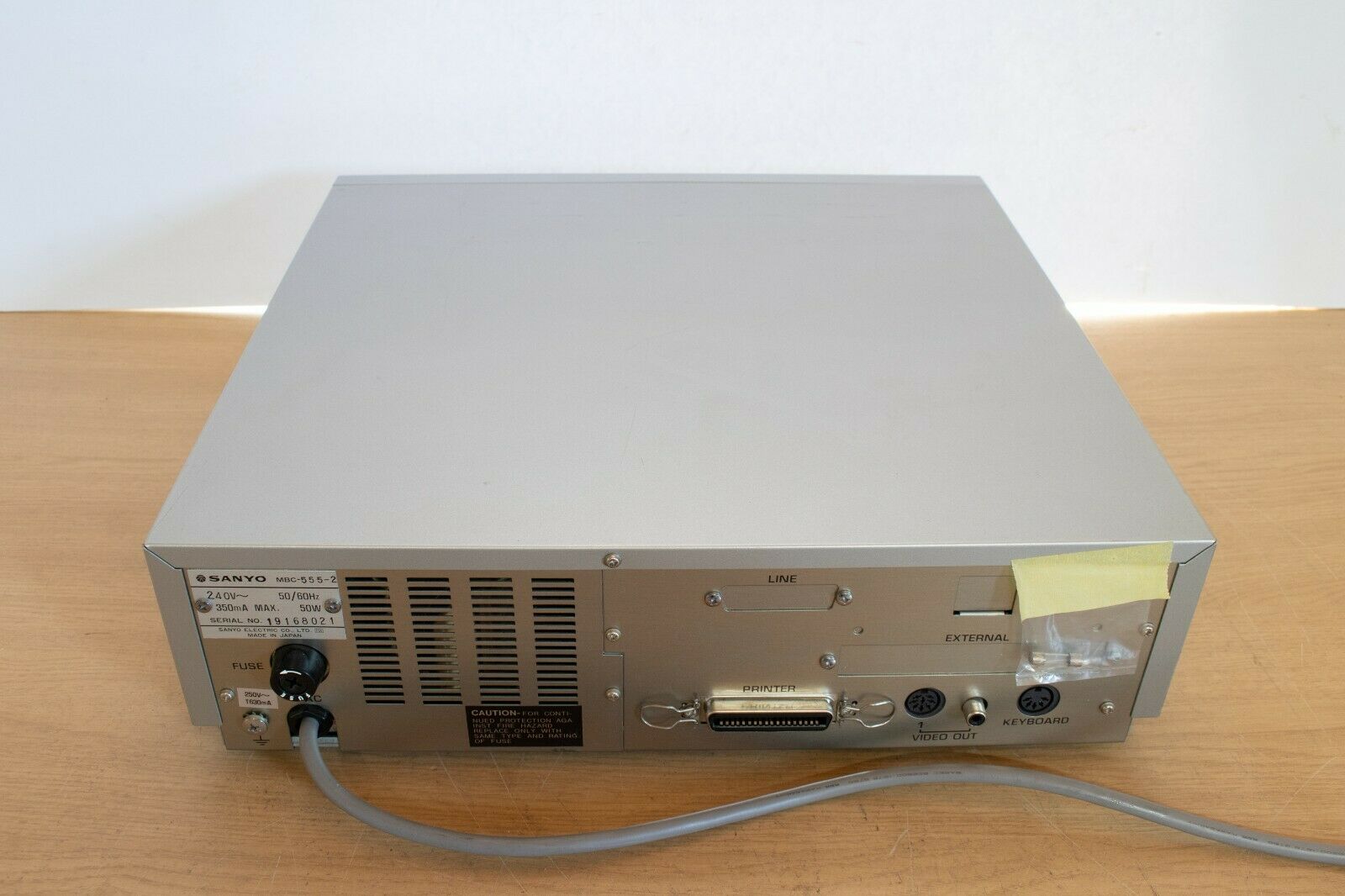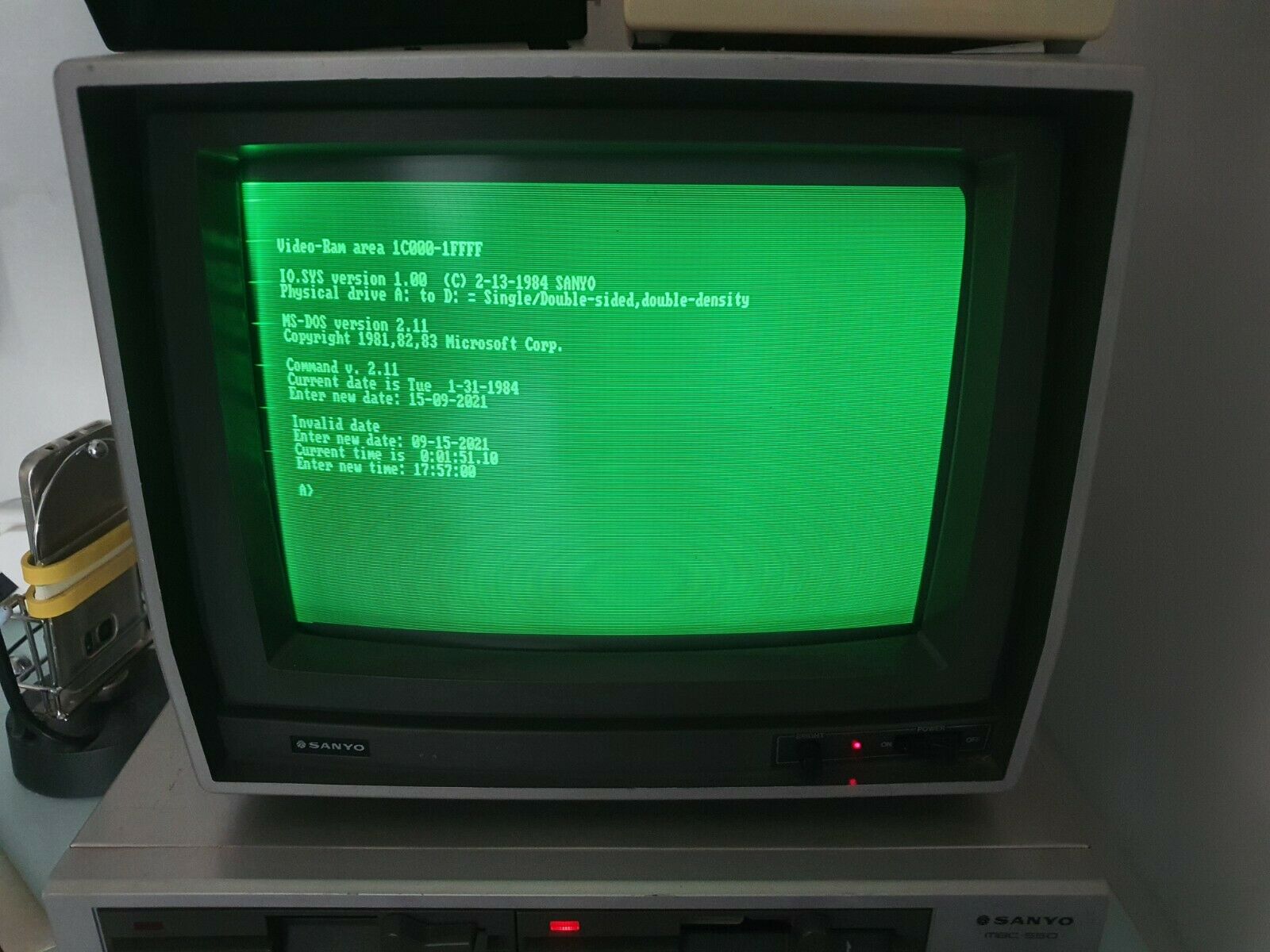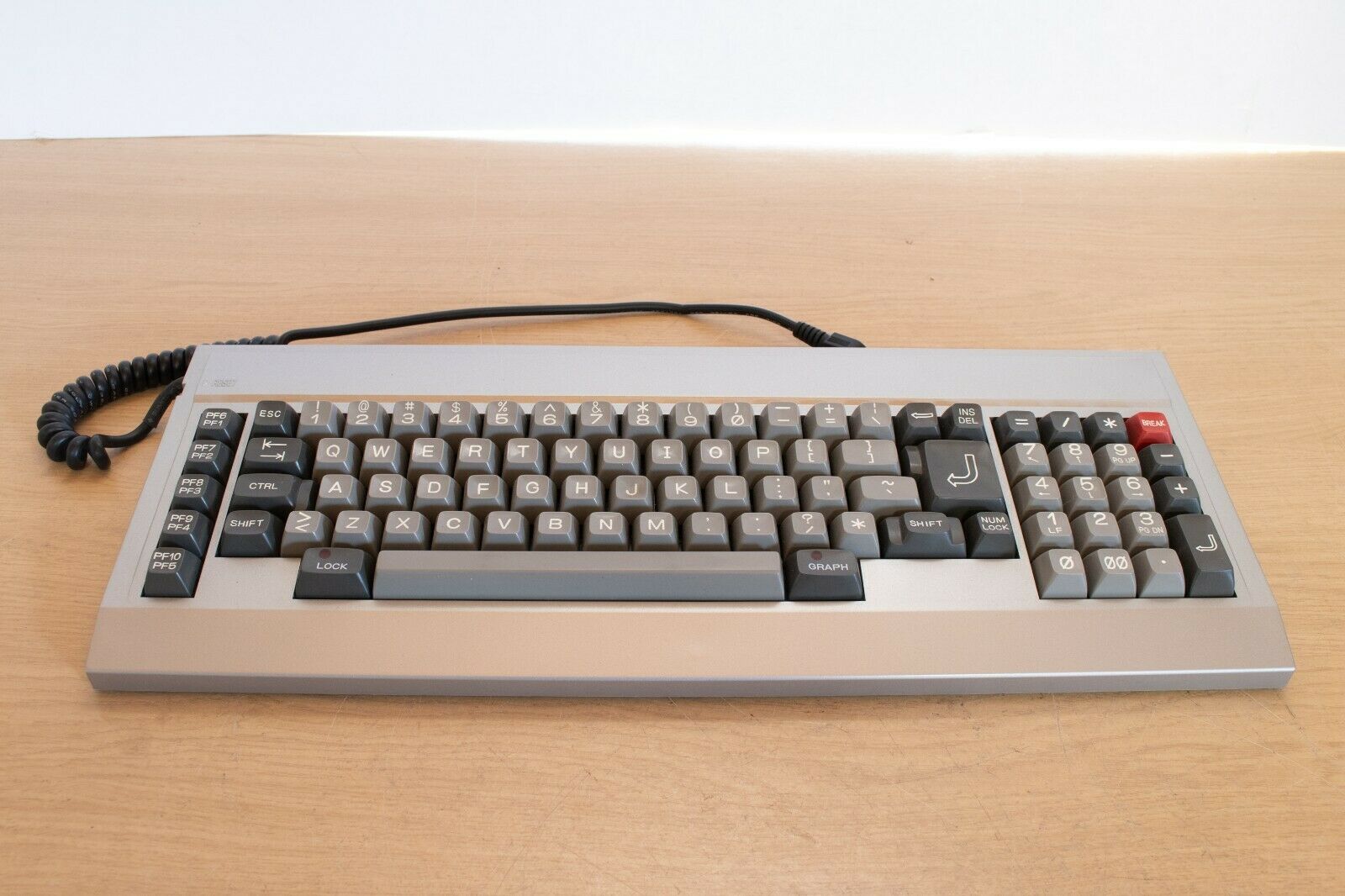Sanyo MBC-55x Series
Introduction
Sanyo launched their Personal Computer (PC) range in 1982 with the MBC-550 (in Japan it was simply MBC-55), with the MBC-555 added shortly after. The MBC-55x series was designed to compete with IBM's PC-XT, featuring the same Intel 8088 CPU and ran a version of MS-DOS. In Japan, the MBC-55 came with the Kanji character set and ran the CP/M-86 operating system. It was famously the first of the IBM PC-compatibles that retailed for under $1000 (see our page on 1982 PC prices for comparison).
To reach this price point though meant compromise. It wasn't 100% IBM-compatible at the hardware level, and it was actually the only PC that clocked slower than the original IBM PC at 3.58 MHz (the IBM PC system clock ran at 4.77 MHz), giving it a Norton SI rating of 0.8. It's also a misnomer that the MBC-55x was a 16-bit computer. The Intel 8088 microprocessor works internally with a 16-bit bus, but external to the CPU it can only work on an 8-bit bus. This was part of the shrewd PC clone marketing that wasn't uncommon at the time.
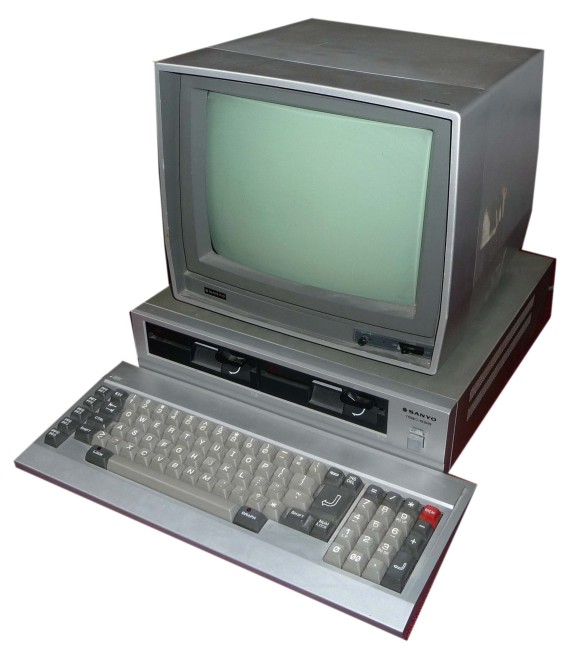
The Sanyo MBC-550 - manufactured up to 1988,
over 10,000 are known to have been sold worldwide
The package looked quite sleek and unusual in silver, given that the majority of clones were in bland light grey/light brown cases - the system unit measured a petite 380 x 112 x 360 mm and the keyboard was 442(W)x45(H)x174(D) mm.
The series comprised the following models:
- MBC-550 : 1 x 5.25" disk drive (160 KB)
- MBC-555 : 2 x 5.25" disk drive (160 KB)
- MBC-555-2 : 2 x 5.25" disk drive (360 KB)
- MBC-555-3 : 2 x 5.25" disk drive (720 KB)
There was a choice of two monitors:
- CRT 70 Colour monitor - supported 8 colours including black and white, 640 x 200 (in 8 colours), 8x8 character box, 6x7 character font, 80x25 character lines on-screen, 15.75 kHz horizontal frequency.
- CRT 30 Monochrome monitor - 640 x 200 dot graphics, 8x8 character box, 6x7 character font, 80x25 character lines on-screen, 15.75 kHz horizontal frequency.
All models in the series came with the following ports on the back of the system unit: Centronics parallel port, Keyboard socket (5-pin DIN which is *not* IBM compatible), two video connectors (8-pin DIN socket for RGB, and a coaxial connector for composite output).
Outside of Japan, all units shipped with two system disks: MS-DOS v2.11 and SANYO BASIC, plus an 'Applications' floppy disk with productivity software from MicroPro comprising WordStar, SpellStar, and InfoStar. In some cases a different word processor was shipped - EasyWriter in place of WordStar.
Optional Accessories
From initial launch you could also purchase some optional accessories including an RS-232c serial card which provided 1 socket and supported 150-1200 baud asynchronous serial communication. Another optional extra was the expansion RAM card which added 128 KB of system RAM (in 8 x 4164 chips).
Compatibility
Whilst easily being mistaken for a true IBM PC-compatible computer, as mentioned earlier it was not hardware compatible. The MBC-550 had no BIOS (Basic Input/Output System) like the IBM did, instead having only a minimal bootloader in ROM which accessed the MBC's hardware directly in order to load a BIOS that would then remain in RAM while the system was switched on.
Retail Prices
At its launch an MBC-550 with amber monitor retailed for $999.
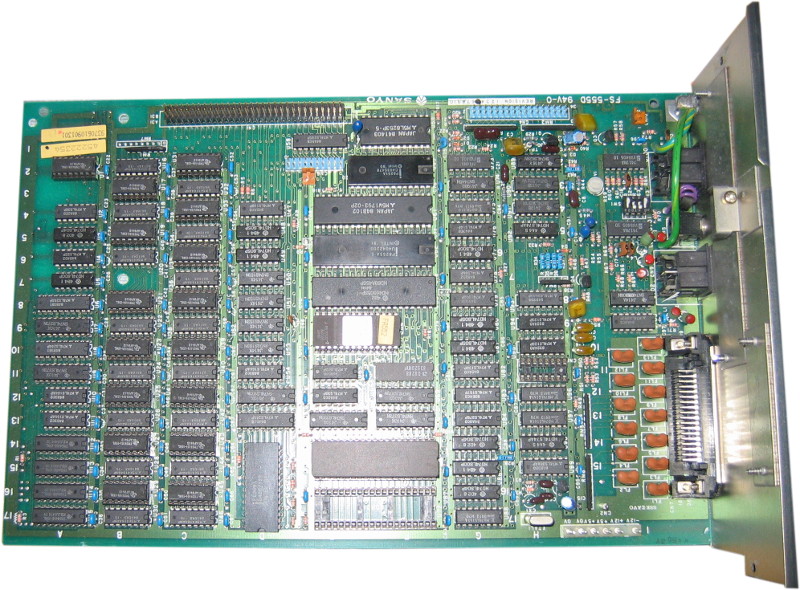
The MBC-555 Mainboard
Hardware - BIOS
Rather than doing what other clone manufacturers were doing (duplicate the IBM PC's circuitry and ROMs), Sanyo Business System designed their own circuitry and their own BIOS, part of which was on an 8 KB ROM chip with the other part on floppy disk to be loaded at boot time. The character set was also in ROM. This meant the Sanyo MBC-55x series was the first of the "legitimate" clones of the IBM Personal Computer.
Note that the system will not display anything on the screen until a boot disk has been inserted, so if you are testing one of these for the first time don't be too concerned if you get a blank screen on startup! The system is constantly attempting to read the boot sector from a disk in Drive A:. Before the operating system has loaded, the CGA circuitry cannot output a signal containing the sync needed to display anything because the CRTC (the video controller chip) has yet to be initialised.
Hardware - Floppy Drives
The MBC-55x series came with 5.25" floppy drives sized from 160 KB to 800 KB. One thing the machine had that was odd was a floppy controller that could support up to 4 floppy drives - you simply chained them and adjusted the DSx [drive select] jumper on the drives. The drives were labeled A,B,C, and D so if a hard drive was added it became E: even if you only had 2 floppy drives as the BIOS reserved A: to D: for floppy drives. The floppy drives in these models were from TEAC - the 160 KB drives were model FD-55A. It's assumed the double-sided sibling of this, the FD-55B was fitted to the MBC-555-2 variant.
Interestingly, the drive lights always stayed on when the door was closed. They did not go out even if the drive was not currently being accessed. This was because the drives report the "drive ready" signal on pin 34 and the MBC depends on this. Most PC-compatibles instead report "disk changed". Note the floppy cable also lacks a twist, similar to the Amstrad PC1640.
The floppy disk controller was integrated into the motherboard, and could not be disabled (in case of failure with a view to replacing it with an expansion card).
If a Sanyo MBC-55x only has a single floppy disk drive, rather than just providing a blanking plate over the empty bay, Sanyo thoughfully provided a handy disk storage area!
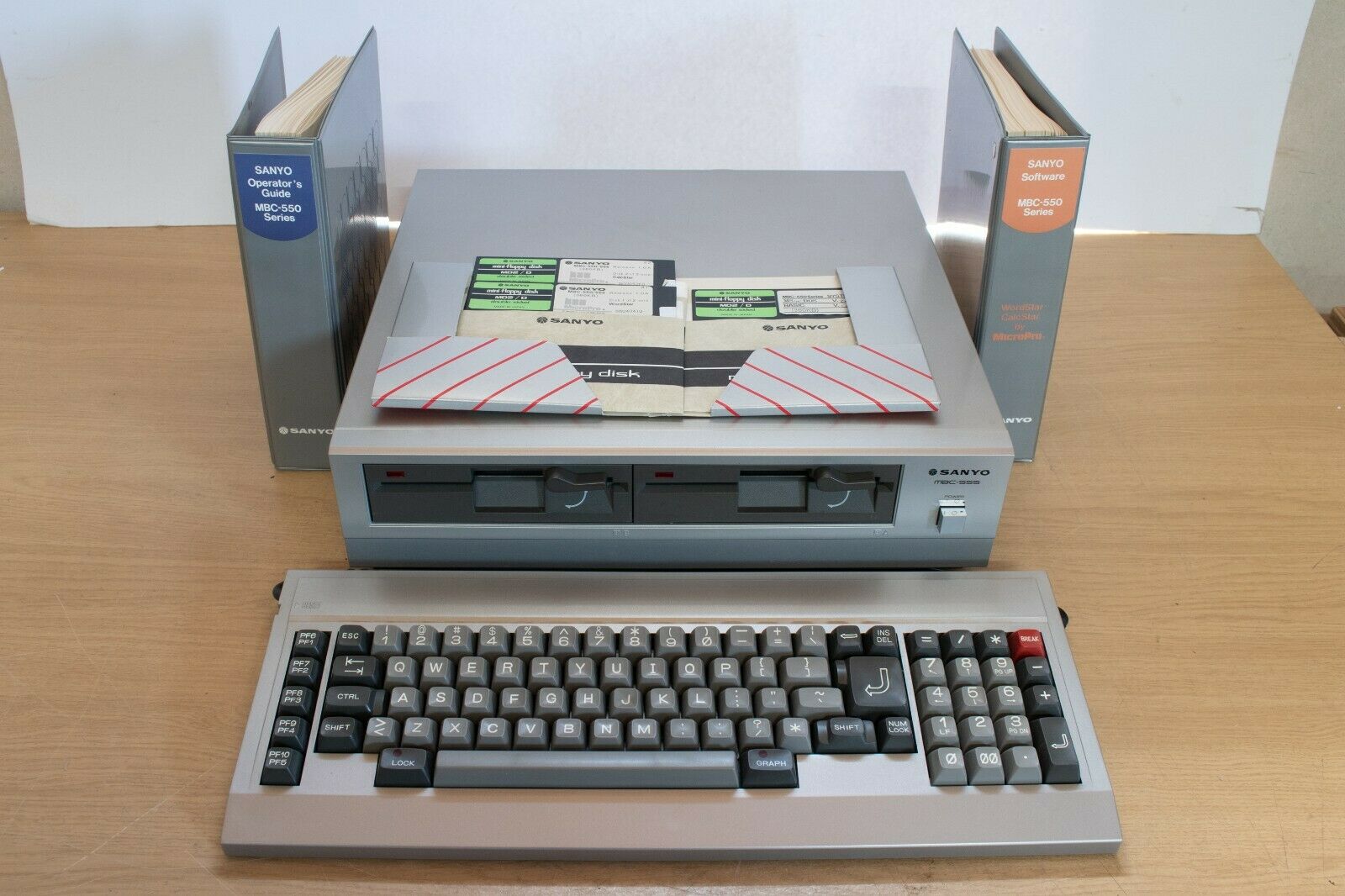
The MBC-555 system unit with keyboard
and bundled information / software binders
Hardware - Hard Disks
The mainboard had a pin header which supported the connection of a 5 MB hard disk, though later some owners managed to get up to 20 MB hard disks working.
Hardware - Video Output and Memory Access
Its video output was loosely based on IBM's CGA (Colour Graphics Adapter) standard but was proprietary. Whilst CGA was capable of displaying 4 colours at 320x200 or 2 colours at 640x200, the MBC-550 could display 8 colours at 640x200. Sanyo's out-of-the-box graphics were easy to use: three straight 640x400 bitplanes, R, G, and B. There was no text mode, so stock IBM PC apps that bypassed the video BIOS did not work. The MBC-55x series all had 48 KB of on-board video RAM.
The main add-on card was a Sanyo CGA color card that transformed the original Sanyo into about a 90% IBM-compatible computer from a video output perspective - a lot of "IBM PC" software at the time accessed the address of the video cards directly at memory address B800:0000 for color and B000:0000 for monochrome. Since the Sanyo had no video card at this address the video output was never seen. Sanyo offered the CGA board that was present at this address for direct memory writing. Two CGA boards were available - the first provided just the CGA compatibility, and a larger version contained a 256 KB RAM expansion as well.
HARDWARE - MEMORY
The standard MBC-55x motherboard came with 128 KB of 4164 DRAM chips in two socketed banks. It could be expanded to a maximum of 256 KB on the motherboard. With the larger of the two CGA expansion boards, a total of 512 KB of memory could be achieved.
HARDWARE - KEYBOARD
The MBC-55x computers used a proprietary keyboard interface, so a standard PC/XT keyboard will not work. The keyboard was manufactured by Fujitsu and uses leaf springs under the key cap for a solid, full-stroke clicky feel. It comprises 81 keys including 5 programmable function keys (holding SHIFT provides F6-F10)
Hardware - POWER SUPPLY
The MBC-55x came with either a linear 50-watt or 90-watt power supply that was built into the system unit. Different power supplies were used for 120V supply and 240V supply.
Operating System
To make the computer run MS-DOS, Sanyo commissioned Microsoft to write a special version of MS-DOS (v2.11) and its command interpreter (COMMAND.COM) that would work on the MBC series. The special support for the Sanyo is contained within the file IO.SYS, where it reports video on interrupt 10h, disk on interrupt 13h, keyboard on interrupt 16h etc. All software making PC "ROM BIOS" calls are then redirected to this "RAM" BIOS (since IO.SYS is loaded into RAM).
**UPDATE** The MBC-55x series actually came with one of two operating system choices: Sanyo DOS v1.25 or v2.11. Both were special versions made to work with the MBC-55x, but only the latter could work in 'native' as well as 'CGA' mode, so if you purchased the CGA add-on card you perhaps got v2.11 bundled with it? (not sure).
Software
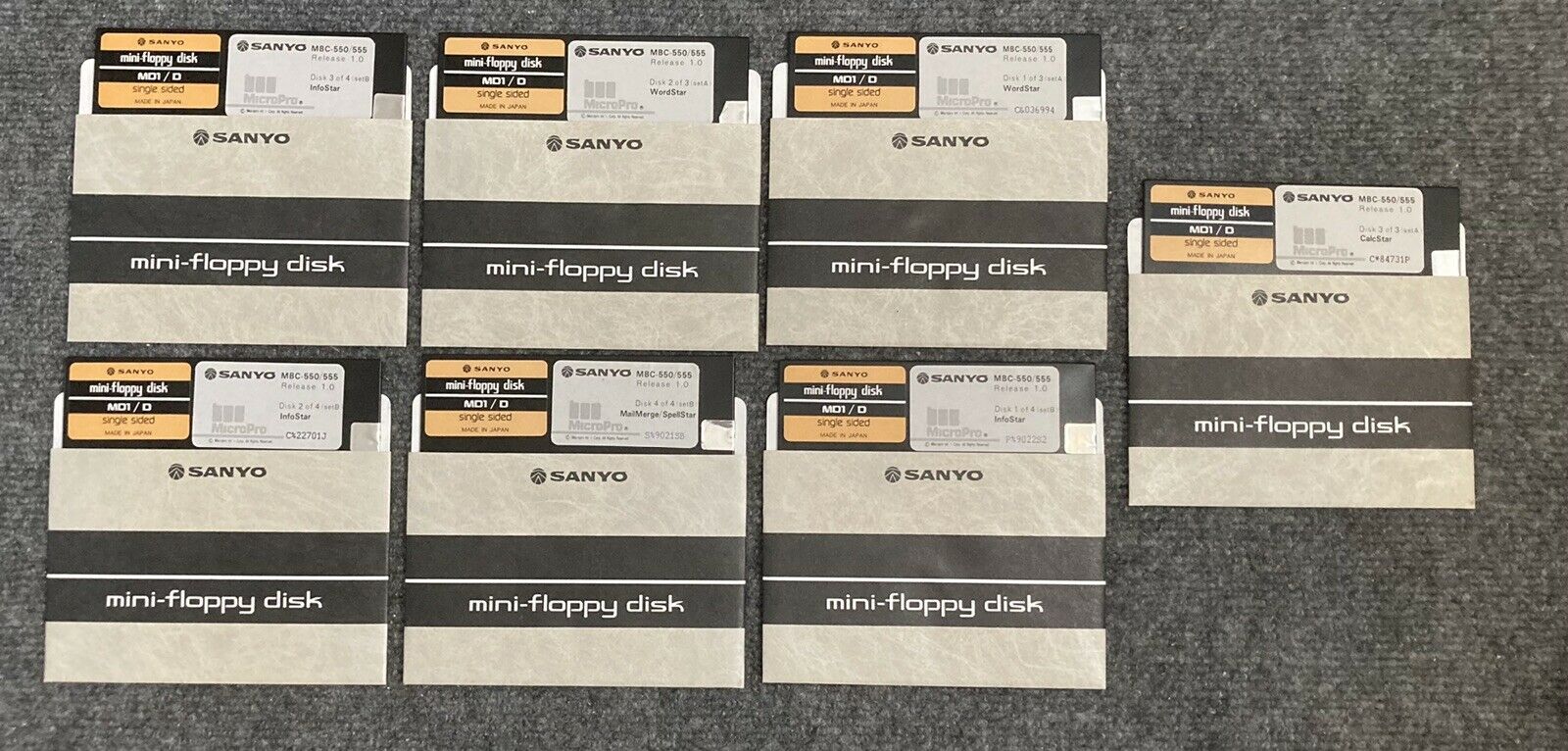
Bundled Software from MicroPro
The MBC series came bundled with productivity software from MicroPro: WordStar 3.3, CalcStar, DataStar, MailMerge, and EasyWriter. It also came with BASIC (version unknown but a known-working GW BASIC program had to be reworked to run successfully on th Sanyo). These applications were specially rewritten to work with the Sanyo MBC series.
While the mixed text-and-graphics video made it incompatible with many programs intended for the IBM PC (Lotus 1-2-3 and Microsoft Flight Simulator were the benchmark for IBM PC compatibility at
the time), WordStar worked just fine, as did Microsoft Excel (the original MS-DOS version) and also Borland's Turbo Pascal compiler. If
your consideration was more for file interchangeability (it ran MS-DOS 2.1) than for software compatibility, the Sanyo was a solid,
workhorse system at a very reasonable price.
Discontinuation
By August 1985 InfoWorld reported that Sanyo "has initiated a campaign to sell off" its MBC-550 inventory. The company's newer computers were, an executive claimed, 99% PC compatible.
Expansions
Memory
The basic MBC-550 came with 128K in sixteen 4164 RAM chips, all soldered in. There were sockets
for another 16, to make 256K in total. Over the years, a number of memory expansions were devised. Sanyo themselves came out with the VB-512, which added another 256K in 41256s
and also provided an IBM-standard CGA output (but the Sanyo's native 640x200
8-colour RGB looks much nicer). It stacked on top of the horizontal 62-pin
header. You could add another bank of sockets and chips to the VB-512 and bring the
total to 640K, or 736K with a bit more work (read: hardware hacking).
However, the VB-512 would not work with either of the two speed-doubler
boards which were developed for the Sanyo by Tampa Bay Digital and by Jack
Farrow.
Tampa Bay Digital produced a board called the Missing Link, which added 512K to give a total of 768K in native Sanyo video mode or 736K if using imitation-IBM video. This board also used the 62-pin header, and you also had to move one of the 4164s from the motherboard to the Missing Link and plug a ribbon cable DIP header into its original socket. The Missing Link included a battery-powered real-time clock, and a software emulation of IBM video (very slow). I have a Missing Link in my Sanyo.
The Northeast Electronics 960K upgrade, along with several others, employed "piggy-backing" of chips (three high!) on the motherboard, along with lots of cutting and soldering of chip pins and trace-cutting on the underside of the motherboard. I don't know the details, or how much of that 960K memory was actually usable, because the video had to be put someplace although it could be relocated during bootup.
Various people came up with ways to replace the socketed 4164s with 41256s, with additional wiring and devices to handle the addressing etc. Some of these could take you to 640K without any trace-cutting.
As of a few months ago, there was still a Sanyo 550 Hackers Newsletter (using the term "hackers" in its original non-derogatory sense), run since the beginning of time by Victor Frank in California. He also tries to help out people with other older (CP/M) Sanyo machines such as the 1100/1150, 1200/1250, 4000/4050, etc.
And AFAIK, the legendary Jack Farrow is still offering his full range of
Sanyo 550 upgrades, including 640K and 896K memory upgrade kits, a
speed-doubler board, a new BIOS ROM, an IBM-compatible serial board, a
simulator board for IBM video and an operating system to run it, and an
operating system called ANYDISK which can handle all of the third-party 40-
and 80- track disk formats which were used in the Sanyo over the years. I
have most of his stuff, along with more than nine years of the Newsletter
and three years of Soft Sector magazine.
CGA Board
The CGA board came with a Sanyo Video Board Boot Disk. If you boot the system using this system disk, you will not be able to see the regular display but only the CGA output.
Hard Drive Support
There was a pinout on the motherboard for a ribbon cable that would accept a 5 MB hard disk. Since the stock power supply only had capacity for ~ 90W, a common upgrade was to replace this transformer/linear PSU with a more modern switching power supply that could cope with more current draw. Later, hard disk capacities up to 20 MB were found to be possible.
Math Co-Processor
The MBC-55x motherboard also included a socket
for an Intel 8087 math coprocessor, which helped with spreadsheet applications that supported it, such as Lotus 1-2-3.
Operating System
At least two replacement operating systems are known to have been developed for the MBC-55x series: Michtron''s DS-DOS and A-OK's OK-DOS.
Other
Other users found ways to read and write 1.2 MB 5.25" disks and 720 kB 3.5" disks on these computers.
Media
A monthly magazine called 'Soft Sector' was written exclusively for the MBC-55x series community.
Computer Shopper magazine ran a column specific to the MBC-55x series, called "The Silver Box".
From 1984, there existed the Sanyo 550 Hackers Newsletter, edited (and largely written) by Victor R. Frank based in California, USA. He also was custodian of a disk library of over 500 5.25" disks of software that would run on some version or other of the Sanyo MBC-55x series computers. He has a pretty complete collection of pre-1985 Sanyo Business Systems computers!
There was also the Sanyo Users' Group in New York, run by Patrick Yanez. SUG provided a disk library service where you could obtain software that would run on the MBC-550 series.
Pricing
In New Zealand's Bits & Bytes Issue 2-8, the retail price of each model variant was as follows:
MBC-550 $2,395.00 (includes MS-DOS, BASIC, WordStar, CalcStar - not including monitor, but does include 40% sales tax)
MBC-555 $3,295.00 (includes all above plus MailMerge, InfoStar and SpellStar - not including monitor, but does include 40% sales tax)
Further Info
Gerry Brophy maintains a Sanyo MBC-55x disk image archive of MBC-compatible software at his website at http://www.eriscreations.com/sanyo/index.html
The disk archive has two formats of disk images:
.img were compressed using DSKIMAGE program here (should be in the middle of the list) running on MS-DOS 6.22 (not on a PCJr) to make the images, using the settings 40 tracks, 1 head, and 8 sectors.
.td0 were compressed with teledisk 1.15
Gerry can be contacted gerry@eriscreations.com

